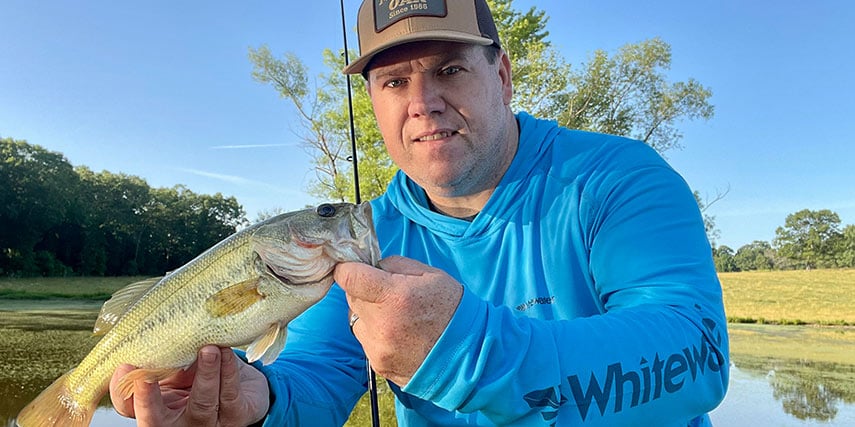In recent years, one of the most talked about tactics in the world of fishing has been forward-facing sonar. The popular modern method of finding and catching fish has given walleye anglers another tool to put in their arsenal, whether they are a weekend fisherman or tournament anglers with money and prizes on the line.
National Walleye Tour angler and co-host of Next Bite T.V. Matt Schiefelbein has seen great success while making some noise in this year's tournament trail. Schiefelbein is only twenty-four, yet he is no stranger to catching big walleye against the sport's toughest competition. He spends nearly two hundred and fifty days on the water fishing for walleye, he has had two tournament wins this year, along with fifteen top tens, and he is sitting in eighth place in this year's angler of the year standings. Although Schiefelbein had a great 2022 without utilizing front-facing sonar on his boat and says that it is not a must for anglers to catch a bunch of walleyes, it does have its advantages. In a recent conversation with Schiefelbein, he shared his fruitful experiences during practicing and tournament competitions, where he says sonar was a massive tool.

“While using a slip bobber on Lake Winnebago, I was using forward-facing sonar to chase down individual fish, “says Schiefelbein, who caught all ten fish in one spot during that tournament. “I would not make a cast unless I saw a fish on the sonar.” On day 2, Schiefelbein had four fish and needed one more big fish to ensure he finished within check range. “I scanned around, found one, and pitched to it; as soon as my line hit the water, the fish came and ate it.” Without forward-facing sonar, he wouldn’t have been casting in that specific location, yet because he knew there was a fish, he could finish with a top fifteen at that tournament.
Schiefelbein explained a few of the most significant advantages that walleye anglers can witness when using forward-facing sonar and how it has impacted his recent success.
Key Advantages
“One of the most significant advantages for me using forward-facing sonar is that it gives me a huge confidence boost. I know that I am casting at a fish, compared to what we call ghost trolling, where you are trolling over a piece of structure in hopes that a fish is nearby.” Schiefelbein explained that having a tool to watch his bait go directly toward the fish produces more confidence that he will hook it.
Another key feature, even when trolling, is the ability to scan under the water before fishing. “I’ll troll up and scan a piece of structure first to see where the fish are because nine times out of ten, walleye setup on the upwind side of the structure, yet double checking is a nice feature on the boat,” says Schiefelbein. He backed that statement by giving a recent example that occurred while recently scouting before a tournament. Schiefelbein stated that he went over a piece of structure and had a few fish on the screen, so he knew fish were present. Because he knew fish were nearby, he used the front-facing sonar to scan over the top to confirm, then trolled back over the area where he soon caught fish.

When trying to find large bolder piles under the water, Schiefelbein relies on forward-facing sonar to help narrow the search. “You find little key spots amongst the bolder piles and find how fish travel.” Many anglers think walleye do not travel as much, yet; they move around a lot. Those key features can help narrow their pattern down when ready to fish.
When searching for the tools to pinpoint specific areas where walleye are located, Schiefelbein recommends practicing casting accuracy. “It is a lot easier to make short pitches from thirty to forty feet when using sonar, compared to making one-hundred feet cast accurately.” It is crucial to be accurate and figure out how far the distance is, just as it is with his other sport of choice, hunting. He says it took time for him to learn different distances and settings before successfully using them while fishing. Once the angler learns distance and accuracy, they can use front-facing sonar to locate fish, then quickly cast nearby, which typically results in more fish.
As Schiefelbein compared judging distance when fishing as he would when hunting, he also agreed that using front-facing sonar as a scouting tool is like that of a hunter trying to narrow down their stand location. “While recently fishing Sault Ste Marie, I was encountering a lot of fish in practice, and I noticed they were sitting in large schools. After observing what types of structures they were sitting on, I would drive around and use my forward-facing sonar to find them. Even though I didn’t fish, I marked where all the fish were on my map, so I could return to that spot when it was tournament time.”
It is a must-try for anglers who have not tried front-facing sonar when walleye fishing. Walleye anglers are gaining massive advantages of seeing structures and locating fish on their screens before picking up their pole to make a cast. By knowing the target, before casting, they are one step ahead of the game, every cast.











